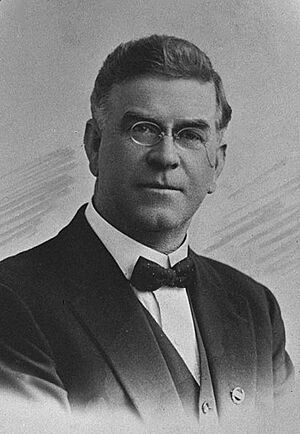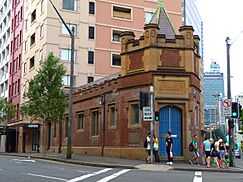John Storey (politician) facts for kids
Quick facts for kids
John Storey
|
|
|---|---|
 |
|
| 20th Premier of New South Wales Election: 1920 |
|
| In office 13 April 1920 – 5 October 1921 |
|
| Preceded by | William Holman |
| Succeeded by | James Dooley |
| Personal details | |
| Born | 15 May 1869 Huskisson, New South Wales |
| Died | 5 October 1921 (aged 52) Darlinghurst, Sydney, New South Wales, Australia |
| Nationality | Australian |
| Political party | Labor Party |
John Storey (born May 15, 1869 – died October 5, 1921) was an important Australian politician. He served as the Premier of New South Wales, which is like being the leader of the state government. He held this role from April 1920 until his sudden death in Sydney in October 1921.
John Storey's leadership was key for the Labor Party in New South Wales. He helped the party become strong again after a big disagreement about conscription. He made sure the party focused on practical solutions for people, rather than just strict socialist ideas.
Early Life and Interests
John Storey was born in Huskisson, Australia. His parents, William John and Elizabeth Graham, were immigrants from England. His father was a shipbuilder.
When John was six, his family moved to Balmain. Sadly, his father died soon after. John went to Darling Road Superior Public School and also attended night school.
At 14, he started learning to be a boilermaker. He worked at Mort's Dock, which was a big shipbuilding and repair yard. John was also very active in sports. He helped start the Balmain Cricket Club in 1897. He was a great all-rounder for their top team. In 1908, he also helped create the Balmain District Rugby League Football Club.
Becoming a Politician
John Storey joined the Labor Electoral League in 1891. This group later became the Labor Party. In 1901, he was elected to represent Balmain North in the New South Wales Legislative Assembly. This is like being a member of the state parliament.
He was a good parliamentarian. However, he lost his seat in 1904 but won it back in 1907. When the McGowen Labor government came to power in 1910, John Storey chose not to join the Cabinet.
In 1916, there was a big disagreement within the Labor Party. The party tried to remove the Premier, William Holman. They elected John Storey to lead the Cabinet instead. However, the party soon changed its mind, and Storey gave power back to Holman.
The party split even more over the issue of conscription. This was about whether people should be forced to join the army. In November, Holman was removed from the Labor Party. The remaining Labor members became the opposition to Holman's government.
John Storey did not want to be the party leader at first. So, Ernest Durack was chosen. But Durack resigned unexpectedly in February 1917. This meant John Storey had to accept the leadership role. His good public speaking skills helped the Labor Party do better in the 1917 election, even though they still lost.
He worked hard to keep the party united. For the 1920 election, he promised things like child support and electric trains for Sydney. These were practical ideas, not just big socialist changes.
Premier of New South Wales
Labor won the 1920 election by just one seat, making John Storey the Premier. His government had a very small majority. This made his job difficult, especially with many opponents in the New South Wales Legislative Council. He also suffered from a kidney illness called nephritis.
His private secretary at this time was Vere Gordon Childe. Childe later became a very famous archaeologist. He wrote a book about how the Labor government worked, based on his time with Storey.
In June 1920, Premier Storey asked Judge Norman Ewing to investigate a case. This case involved 12 members of the IWW (Industrial Workers of the World) who were jailed in 1916. Based on Ewing's advice, ten of them were released in August.
In early 1921, Storey needed to travel to London. He wanted to meet with financial experts and see a doctor. To prevent his government from being overthrown while he was away, he temporarily stopped Parliament from meeting. Even though his doctor warned him, he worked very hard in London. He continued to work hard when he returned to Sydney in July.
Death and Legacy
John Storey became very ill and was admitted to Clermont Private Hospital in Darlinghurst. He passed away there on October 5, 1921. He was survived by his wife, three sons, and two daughters.
His funeral was held at St. Andrew's Cathedral on October 7, 1921. He was buried at the Field of Mars Cemetery in Ryde.
In 1926, another Premier, Jack Lang, opened the John Storey Memorial Dispensary. This clinic was built in Chippendale, New South Wales. It was a way to remember John Storey and his work. Today, it still operates as a pathology clinic, helping people with medical tests.


